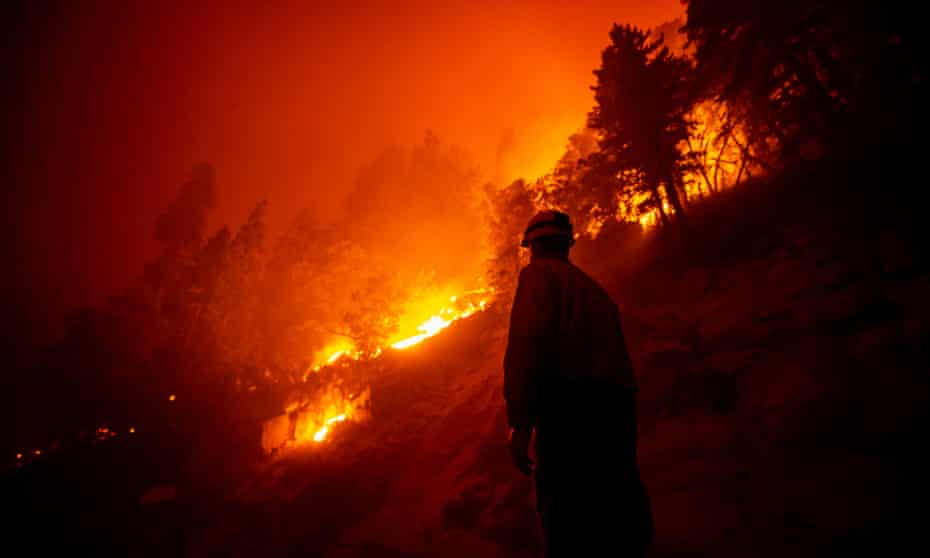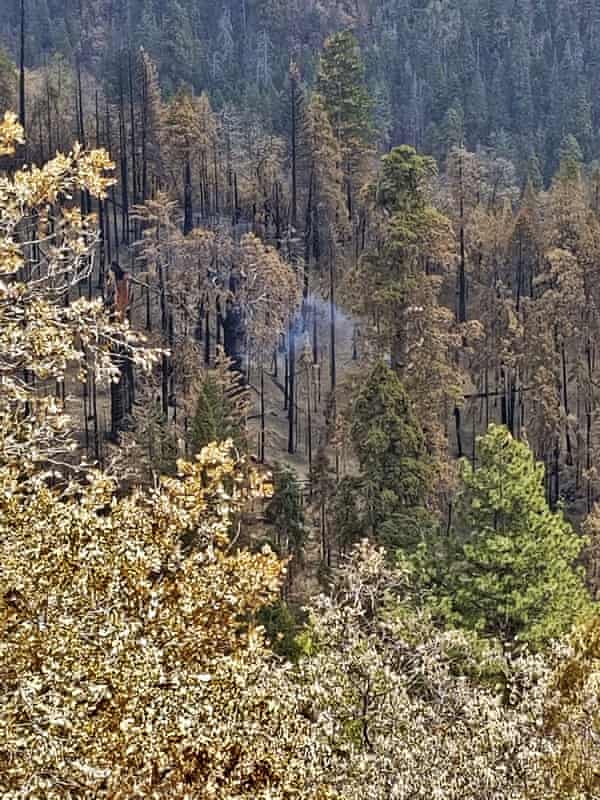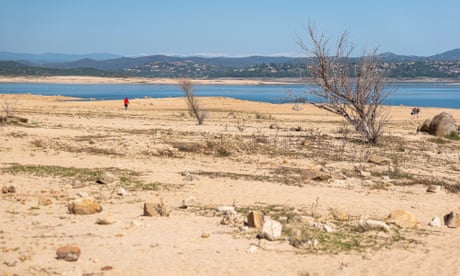
A firefighter checks on the evolution of the Castle Fire as it burns in the Sequoia national forest in September. Photograph: Étienne Laurent/EPA
Charred tree – which may be thousands of years old – looks like chimney spouting smoke in national forest
Charred tree – which may be thousands of years old – looks like chimney spouting smoke in national forest
Jack Herrera in San Francisco
Thu 6 May 2021
Scientists have discovered a giant sequoia still smoldering in California’s Sequoia national forest, months after wildfires tore through the region last August.
The tree was found, charred but still standing, by researchers in the lower part of the national forest this week. While turning down a sharp switchback on the trail, a member of Sequoia’s fire ecology and research team spotted a plume of smoke in the ravine below. Using a long camera lens, the team tracked the smoke to a single giant sequoia, standing in the burn area from last year’s Castle fire. The enormous tree, which has probably stood for hundreds if not thousands of years, looked like a chimney spouting smoke in the middle of the blackened forest.
In August, lighting struck deep in Sequoia national forest. The resulting Castle fire spread into areas of the Giant Sequoia national monument, home to trees that have stood for over 2,000 years, including “General Sherman”, the largest tree on earth. For weeks the Castle fire burned through 150,000 acres of land, before crews managed to contain the blaze in late December.

The smoldering tree in Sequoia national forest. Photograph: Tony Caprio/AP
Now researchers know that while the flames disappeared, some embers remained smoldering throughout the winter. The fire inside the tree discovered this week was sheltered inside the tree for months, even through the winter’s rain and snowfall.
Mike Theune, fire information officer for Sequoia and Kings Canyon national parks, said it was not wholly unusual for some patches of ember to remain burning months after a fire dies down. The inside of a tree, like the interior of a wood-burning stove, can provide an oxygen-rich shelter for a fire to survive. However, the fact that a Sequoia is still giving off smoke after an entire winter of rain and snow could be testament to California’s exceptionally dry winter: after precious little snowfall over the last two winters, most of the state is entering extreme drought conditions.
“The vegetation – the fuels – are dry,” Theune said. “They don’t have the high moisture content that [could prevent fire].” Elsewhere in the state, experts have warned that the unprecedented dryness of California’s diverse flora could lead to an early and devastating fire season this year.
Advertisement
“The fact areas are still smoldering and smoking from the 2020 Castle fire demonstrates how dry the park is,” Leif Mathiesen, the assistant fire management officer for Sequoia and Kings Canyon, said in a statement. “With the low amount of snowfall and rain this year, there may be additional discoveries as spring transitions into summer.”
While last year’s fires claimed thousands of acres of land, Theune said it was important to remember that many of the sequoias in California’s Sierra Nevada mountains have stood for thousands of years and have survived millennia of forest fires and droughts.

Parts of California see May red flag fire warning for first time since 2014
Read more
“But at the same time, we are seeing the impacts of climate change, high fire severity, and long-term extended drought periods,” Theune said.
Sequoias have a complex relationship with fire. For much of the20th century, foresters worked to prevent fires within the nationally protected land, hoping to defend the ancient tree. Then, in the early 1960s and 1970s, researchers working the park made a startling discovery: in areas where fires had burned, young sequoia saplings flourished, even as the forest floor elsewhere in the park remained barren of new trees. That observation led to the discovery that giant sequoias depend on fire to release their seeds.
Because of sequoias’ need for fire, California fire officials working out of Sequoia national forest were some of the earliest proponents of prescribed burns – among California government officials, that is. Intentional, controlled burns have been practiced by Indigenous people in California for thousands of years as a form of land husbandry. In the 60s and 70s, officials in Sequoia intentionally lit fires in controlled areas, and low-intensity fires created by lighting strikes were allowed to burn.

Now researchers know that while the flames disappeared, some embers remained smoldering throughout the winter. The fire inside the tree discovered this week was sheltered inside the tree for months, even through the winter’s rain and snowfall.
Mike Theune, fire information officer for Sequoia and Kings Canyon national parks, said it was not wholly unusual for some patches of ember to remain burning months after a fire dies down. The inside of a tree, like the interior of a wood-burning stove, can provide an oxygen-rich shelter for a fire to survive. However, the fact that a Sequoia is still giving off smoke after an entire winter of rain and snow could be testament to California’s exceptionally dry winter: after precious little snowfall over the last two winters, most of the state is entering extreme drought conditions.
“The vegetation – the fuels – are dry,” Theune said. “They don’t have the high moisture content that [could prevent fire].” Elsewhere in the state, experts have warned that the unprecedented dryness of California’s diverse flora could lead to an early and devastating fire season this year.
Advertisement
“The fact areas are still smoldering and smoking from the 2020 Castle fire demonstrates how dry the park is,” Leif Mathiesen, the assistant fire management officer for Sequoia and Kings Canyon, said in a statement. “With the low amount of snowfall and rain this year, there may be additional discoveries as spring transitions into summer.”
While last year’s fires claimed thousands of acres of land, Theune said it was important to remember that many of the sequoias in California’s Sierra Nevada mountains have stood for thousands of years and have survived millennia of forest fires and droughts.

Parts of California see May red flag fire warning for first time since 2014
Read more
“But at the same time, we are seeing the impacts of climate change, high fire severity, and long-term extended drought periods,” Theune said.
Sequoias have a complex relationship with fire. For much of the20th century, foresters worked to prevent fires within the nationally protected land, hoping to defend the ancient tree. Then, in the early 1960s and 1970s, researchers working the park made a startling discovery: in areas where fires had burned, young sequoia saplings flourished, even as the forest floor elsewhere in the park remained barren of new trees. That observation led to the discovery that giant sequoias depend on fire to release their seeds.
Because of sequoias’ need for fire, California fire officials working out of Sequoia national forest were some of the earliest proponents of prescribed burns – among California government officials, that is. Intentional, controlled burns have been practiced by Indigenous people in California for thousands of years as a form of land husbandry. In the 60s and 70s, officials in Sequoia intentionally lit fires in controlled areas, and low-intensity fires created by lighting strikes were allowed to burn.

Smoke rises from the forest. Photograph: Tony Caprio/AP
Theune has stood in the forest during one of these prescribed burns. As the heat from the flames on the forest floor reached the trees’ branches, the sequoia’s cones, protected by a sticky resin shell, melted and opened. From the treetops, hundreds of small seeds, each the size of a pinky nail, floated to the ground below, where the fire had left the floor rich with new nutrients.
As California begins to more actively pursue prescribed burns as a way to manage forest fires, Theune says there are lessons to be learned from ecologists in Sequoia national forest. One of the main instructions: low-intensity fires can be regenerative and prevent more devastating blazes. But high intensity, out-of-control fires are harmful for forests – as evidenced by the recently discovered smoldering sequoia, which stands in a patch of dead and blackened trees.
The sorts of high-intensity blazes California hopes to prevent are being fueled largely by two interlinked phenomena: the climate crisis and increasing human development. California is becoming warmer and drier, which creates enormous risks in the state’s sprawling cities and towns, where vegetation and other fuels have been allowed to build up unabated – and where power lines and residents hold the potential to release perilous sparks.
Theune has stood in the forest during one of these prescribed burns. As the heat from the flames on the forest floor reached the trees’ branches, the sequoia’s cones, protected by a sticky resin shell, melted and opened. From the treetops, hundreds of small seeds, each the size of a pinky nail, floated to the ground below, where the fire had left the floor rich with new nutrients.
As California begins to more actively pursue prescribed burns as a way to manage forest fires, Theune says there are lessons to be learned from ecologists in Sequoia national forest. One of the main instructions: low-intensity fires can be regenerative and prevent more devastating blazes. But high intensity, out-of-control fires are harmful for forests – as evidenced by the recently discovered smoldering sequoia, which stands in a patch of dead and blackened trees.
The sorts of high-intensity blazes California hopes to prevent are being fueled largely by two interlinked phenomena: the climate crisis and increasing human development. California is becoming warmer and drier, which creates enormous risks in the state’s sprawling cities and towns, where vegetation and other fuels have been allowed to build up unabated – and where power lines and residents hold the potential to release perilous sparks.
No comments:
Post a Comment